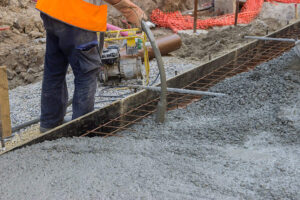Vibrating is a crucial step on several concrete construction projects. This step is extremely important that contractors shouldn’t overlook even the slightest. As an important part of a successful concrete pour, the majority of concrete vibrating procedures are now widely utilized to ensure the accurate compaction of any concrete structures on the entire globe. Concrete contractors, in addition to this, are not trying to be just hands-on in every process but also getting more advanced. By having a builders schedule software during the work, complex concrete processes and methods are easily monitored.
In this blog, the importance of concrete vibration will be discussed and some of the most helpful concrete vibrating tips will be shared as well as the top-picked brands for concrete vibrators.
What is Concrete Vibration?
One of the many important critical steps when pouring concrete is the vibration or consolidation of concrete. When concrete is being poured, it may possess hundreds or perhaps thousands of air bubbles that can extensively weaken the concrete structure. These air bubbles (air pockets) that are normally referred to as honeycombing is a recurring issue that most contractors have faced most of the time. Concrete contractors who are responsible to manage project and other related concrete services have one goal – getting rid of it. Therefore, getting rid of honeycombing or air packets is definitely a must-do. By doing so, it increases the strength and density of the concrete. Tightly packed particles will certainly result in a more durable and stronger concrete structure.
Furthermore, there are basic applications for concrete vibrations that are widely recognized and apply today. These concrete vibration applications can be categorized into 3 basic groups. Take a look below:
- Surface Vibration
In this category, large vibrators that are sometimes termed as jumpers are often directed on manual order into the bare surface of the usual poured concrete. This method has been limited to slab depth for about 7 inches or less, but it actually provides a much smoother surface that is significantly desirable when appearance is considered more important.
Vibrators such as this one, in particular, are one of many traditional and emerging trends in the concrete industry. It is so important to keep up with the latest builders trends nowadays particularly for the individuals who are directly involved in the industry.
- Formwork Vibration
This method is commonly applied during precast concrete construction. It also has an involvement during mounting the vibrators towards the outsides of the concrete forms. As a matter of fact, the external form vibrators are usually spaced apart, 6 ft. in between for larger pours.
- Internal Vibration
The most common type preferably used is the internal concrete vibrators. A single operator can absolutely handle many. The process is just as relatively simple: A worker jams the internal vibrator in a quick manner down to the wet concrete and then afterward, slowly withdraws it.
Concrete Vibrating Tips
The process of concrete vibration will never get started or finished without the use of concrete vibrators. These tools are being used for consolidating concrete and will increasingly reduce the number of air pockets fond inside the concrete mass. Contractors have to keep mind to implement also equipment management. By deploying construction scheduling software in the work, efficient management for tools including the vibrators and other concrete equipment is achievable.
Take into consideration these helpful tips for effective and fast concrete vibration process:
- The most usual and common technique using an internal vibrator is through withdrawing the vibrator slowly. 25mm inch per second is the desirable rate during the withdrawal process. However, if bubbles are still there and still emerging despite the vibrator is already withdrawn, more vibration is necessary.
- In order to prevent cold joints from existing in concrete layers as these will be going to be poured over with new layers of cement mixture, make sure to further penetrate the pour extensively with the use of vibrator. Subcontractors who are going to do this kind of work are best monitored and tracked using a construction schedule software. Scheduling of tasks and tracking labor hours is definitely achieved through utilizing this advanced software application.
- Over vibrating, the concrete is never an advisable thing to do as it allows the mixture to separate and break. Additionally, under vibrating, the concrete must not also be considered as it can able to trap the air in the lower layers specifically on the cement pour. If these procedures are not taken and followed seriously, it leads to a weaker concrete structure that will expectedly break with just minimum pressure.
- For maximizing efficiency, use only vertical movements when applying the process of vibration in order to acquire a more even mixture of concrete and aggregates. Take note as well that horizontal motion is capable of leading uneven distribution and might increase the chance of the vibrator tangling in the reinforcing steel. Additionally, for amplifying team productivity which is also necessary during the entire work and implementation of such procedures is best obtained by having to use a crew schedule software.
- Avoid using the vibrator as a placement tool for concrete because it’ll never produce a solid consistent surface and can cause more problems in terms of structural form and length.
- Use the appropriate and right type of concrete vibrator that varies on the structure currently built. The size of the working area is also one factor to consider apart from this. A compact lightweight type of concrete vibrator is a recommended one preferably used for smaller concrete works.
- Consider getting a back-up concrete vibrator in order to have a secondary replacement tool instantaneously. This is essential just if by any chance, the first one will encounter any issues during the work. Subcontractors often deal and encounter such issues over and over again but by being keen and aware, they’ve successfully overcome it. And also, a project management software is a life-saver, it ultimately saves and helps them in every construction phase.
Utilization of Concrete Vibrator
Because of concrete being broadly used in numerous and varying applications and structures, concrete vibrating tools come in many diverse variations. Concrete vibrators are not only being utilized to consolidate the concrete for achieving maximum density but also on the other way around. This type of tool can also be used to internally mix the different lifts of concrete altogether and form a single solid mass with no air pockets or even lift lines on the already finished exposed surface. There are 4 important factors to take into consideration in choosing the right vibration tool: power, size, frequency, and amplitude.
Below are the 5 top-pick concrete vibrators that are favorably recommended:
Offered by Makita and is innovative, well-built, and extremely well-balanced. This particular product is definitely a high-quality. What most concrete subcontractors like about it is the fact that it is cordless, thus, making the work extra efficient. What also makes the work extra efficient in terms of project management is the application of construction management software.
- This vibrator measures 39” x 24” x 6” and features 12500 max. Vibration each minute.
- Compact and ergonomically designed
- Has dual-direction switch
- Run time is up to 25 minutes and has a weight of 11.4 lbs
- Best suitable for lighter-weight jobs
This cordless type of pencil vibrator is best used to consolidate grout. The tool itself is very light and has a compact option that has been an ideal option in terms of block cores.
- This concrete vibrator has a size of 1 and 1/8 inch in diameter and has a 4’ flexible shaft.
- Underload, it is capable of providing 14000 VPM (vibrations per minute).
The tool is offered by Chicago Electric and known as a heavy, practical, and great choice of patching, construction, and repair jobs. Contractors and subs usually like the design of this despite the expensive standard price of this vibrator.
- The corded concrete vibrator usually measures to 1-7/16” in width
- The weight it features is 43 lbs
- Compact design that is meant to decrease hand fatigue to the users
- Has a vibration head having a length of 16 inches
- Has a protective metal cage
- Take note, when using the Chicago concrete vibrator, it is necessary to get immerse the head towards the wet concrete in order to release excess water and air bubbles.
This is proudly offered by USA Pro and this is an electric type of concrete vibrator. It is practical and handy at the same time but not usually suitable for heavy-duty jobs. It has a reasonable price and is suitable for setting cement rapidly while eliminating all air bubbles, which is why most of the concrete contractors recommended it.
- The USA Pro 1.5 HP has a high-speed corded vibrator
- It features a 60” x 35” shaft needle as well as 1-3/8” breadth head, and a trigger lock for comfort
- Has a 110-v 3-prong plug, 6.5 ft. power cord length and 12000 RMP
Has a sporting simplicity in its design yet very effective. This electric type of tool is ideal to fit for the starters and even for DIY enthusiasts. Furthermore, the tool comes totally packed with a set of essential features that definitely enhances the overall efficiency and reliability.
- Has a heat resistant mechanism that is able to tolerate up to 180-degree Celsius
- 1P65 protection technology for dust penetration prevention
- Electrically powered and has low maintenance needs
- 2480 RPM rotary speeding
Key Takeaways
Take note that selecting either external or internal vibrator, it is basically determined by the type of application. There are instances when a contractor is preferring in using both types and the very common reason why contractors often utilize both types is just an additional measure in order to ensure consolidation. Moreover, the basic methods of using and producing vibration for concrete consolidation haven’t really changed much over the many years. However, technology continues to advance.





